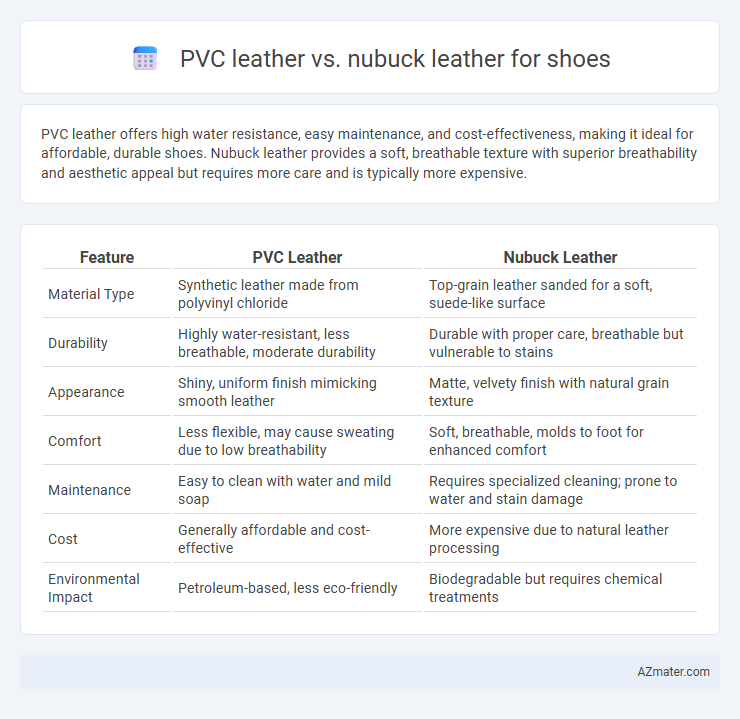PVC leather offers high water resistance, easy maintenance, and cost-effectiveness, making it ideal for affordable, durable shoes. Nubuck leather provides a soft, breathable texture with superior breathability and aesthetic appeal but requires more care and is typically more expensive.
Table of Comparison
| Feature | PVC Leather | Nubuck Leather |
|---|---|---|
| Material Type | Synthetic leather made from polyvinyl chloride | Top-grain leather sanded for a soft, suede-like surface |
| Durability | Highly water-resistant, less breathable, moderate durability | Durable with proper care, breathable but vulnerable to stains |
| Appearance | Shiny, uniform finish mimicking smooth leather | Matte, velvety finish with natural grain texture |
| Comfort | Less flexible, may cause sweating due to low breathability | Soft, breathable, molds to foot for enhanced comfort |
| Maintenance | Easy to clean with water and mild soap | Requires specialized cleaning; prone to water and stain damage |
| Cost | Generally affordable and cost-effective | More expensive due to natural leather processing |
| Environmental Impact | Petroleum-based, less eco-friendly | Biodegradable but requires chemical treatments |
Introduction to PVC Leather and Nubuck Leather
PVC leather, a synthetic material made from polyvinyl chloride, offers durability, water resistance, and affordability, making it a popular choice for shoe manufacturing. Nubuck leather, derived from top-grain cattle hide that is sanded or buffed to create a soft, velvety surface, provides a premium feel and breathability but requires more care to maintain its appearance. Both materials cater to different market demands, with PVC leather excelling in weather resilience and budget-friendly options, while Nubuck leather appeals to consumers seeking luxury and comfort.
Material Composition: PVC vs Nubuck
PVC leather is a synthetic material made from polyvinyl chloride combined with plasticizers, offering durability, water resistance, and easy maintenance ideal for mass-produced shoes. Nubuck leather is crafted from the outer layer of cowhide that has been sanded and buffed to create a soft, velvety texture with enhanced breathability and natural aesthetics. The key difference lies in PVC's artificial polymer base providing a uniform surface, while Nubuck retains unique grain patterns and requires more careful care due to its natural origin.
Appearance and Texture Differences
PVC leather for shoes features a smooth, glossy appearance with a uniform texture that mimics polished leather, offering a sleek and modern look. Nubuck leather displays a soft, velvety surface created by sanding the outer layer, resulting in a matte finish with a subtle nap that provides a natural, rich texture. The distinct tactile feel of nubuck is more breathable and supple, while PVC leather retains resilience and water resistance but lacks the depth and warmth of genuine leather textures.
Durability and Wear Resistance
PVC leather offers superior water resistance and higher durability, making it ideal for shoes exposed to harsh weather and frequent use. Nubuck leather provides excellent breathability and a soft texture but tends to wear faster, showing scuffs and scratches more prominently over time. For long-lasting wear resistance, PVC leather outperforms Nubuck, especially in rugged or wet conditions.
Comfort and Breathability
PVC leather offers water resistance and durability but lacks breathability, often causing feet to sweat and reducing overall comfort in shoes. Nubuck leather, made from top-grain cattle hide with a soft, brushed surface, provides superior breathability and moisture absorption, enhancing comfort during extended wear. Shoes crafted with Nubuck leather allow better air circulation, making them ideal for users prioritizing foot comfort and dryness.
Maintenance and Cleaning Requirements
PVC leather requires minimal maintenance, involving simple wiping with a damp cloth and mild soap, making it highly resistant to stains and water damage. Nubuck leather demands more careful upkeep, including regular brushing with a suede brush to remove dirt and the use of specialized Nubuck cleaners to maintain its texture and appearance. Proper care for Nubuck also involves applying protective sprays to prevent water and oil stains, ensuring long-lasting durability and aesthetic appeal.
Cost Comparison: PVC Leather vs Nubuck
PVC leather is significantly more affordable than nubuck leather due to its synthetic manufacturing process, making it a cost-effective choice for budget-conscious consumers. Nubuck leather, crafted from top-grain cattle hide with a buffed surface, commands a higher price because of its natural materials and labor-intensive production. The durability and premium texture of nubuck justify its elevated cost compared to the lower-priced, less breathable PVC alternative.
Eco-Friendliness and Sustainability
PVC leather, derived from polyvinyl chloride, poses environmental concerns due to its non-biodegradability and toxic chemical release during production and disposal. Nubuck leather, sourced from animal hides, involves resource-intensive livestock farming but is biodegradable and often treated with eco-friendlier tanning processes. For sustainable footwear, Nubuck leather tends to have a lower long-term environmental impact compared to PVC leather, especially when sourced from responsibly managed farms and tanned using vegetable-based methods.
Style Versatility and Design Options
PVC leather offers extensive style versatility and design options due to its ability to mimic various textures and colors, making it ideal for budget-friendly, fashionable shoes with diverse patterns and finishes. Nubuck leather, known for its soft, velvety texture and natural grain, provides a more luxurious and sophisticated aesthetic that suits classic, high-end shoe designs but offers fewer color and pattern variations. Designers favor PVC leather for mass-market, trendy footwear while Nubuck remains preferred for premium collections emphasizing durability and timeless elegance.
Which Leather is Best for Shoes?
PVC leather offers superior water resistance and durability, making it ideal for shoes exposed to moisture and heavy use. Nubuck leather provides breathability and a soft, luxurious texture, enhancing comfort and style but requires more maintenance to prevent stains and wear. For long-lasting, low-maintenance footwear, PVC leather is best; for premium aesthetics and comfort, Nubuck leather is preferred.

Infographic: PVC leather vs Nubuck leather for Shoe
 azmater.com
azmater.com